Aging in place: Top tips on how you can adapt your home
Whether you’re looking for your ‘forever’ home or already live there, adjusting its design will help make your life easier and safer.
Safer living doesn’t have to mean your home has to look institutional. In fact, good design can incorporate safety and make your home look good at the same time. For example, no one would guess that using a contrasting colour palette in certain parts of the home can be primarily for safety reasons.
Here are some suggestions to consider, no matter your age!

Around the home
There are a few simple things you can do in all areas of your home to get started.
- Check if your corridors and doorways are wide enough for a wheelchair to easily maneuver so you’re not bumping into the walls or hitting your hands against doorframes.
- Designing an open floor plan makes moving around easier and safer.
- Using non-slip flooring is vital. It’s best not to have any area rugs, but if you do make sure they’re strongly secured to the floor and their edges don’t create a tripping hazard.
- Consider adding robustly secured wainscotting or chair rails on the walls to aid balance.
- Change round doorknobs to the lever-style to increase accessibility.
- Placing a bench near the entrance is a handy place to transition between inside and outside.
- If you live in a multi-story home, see if one of the main floor rooms be converted into a bedroom and the powder room turned into a full bathroom.
- Add indirect lighting to reduce glare and shadows which are potential tripping hazards for those with weaker depth perception. Experts recommend LED lights between 2,700 and 3,000 lumens as they create a soft white glow.
Bathroom safety
This is one of the more dangerous rooms in a home for anyone.
- Place non-slip flooring, bathtubs, and showers.
- Installing grab bars is vital. You can buy them designed as towel rods and toilet roll holders for a decorative look.
- Install lever-style faucets. They’re more accessible and allow for easier temperature control.
- Using temperature controls and anti-scalding devices can help eliminate potential burns.
- Replace your shower head with an adjustable-height showerhead with a handheld wand.
- Have the door open outward for greater mobility and access.
Be bold with colour
Forget about neutral palettes. High contrasting colours could help prevent injuries and falls. Older adults can have trouble with contrast perception and the use of colour can make potential trouble areas more visible.
- In the bathroom, use strong colours on the floor to make a white toilet seat stand out.
- Decorating with different colour chairs from the flooring helps define the edge of a chair.
- Use contrasting colours on a staircase can highlight the top and bottom steps or mark the edge of each step.
- Consider what colours you’re using. Colour can provide an emotional sense of well-being, which is important too.
Everyday activities
The routine tasks of our everyday lives only need a few tweaks to be more comfortable.
- Install drawers under the countertops in the kitchen, bathroom, and laundry room.
- Use multi-height countertops to accommodate chairs or wheelchairs. Ditto for kitchen islands.
- Switch to front loading washers and dryers. They’re easier for everyone to use.
- Look for fridges with bottom freezer drawers are more convenient.